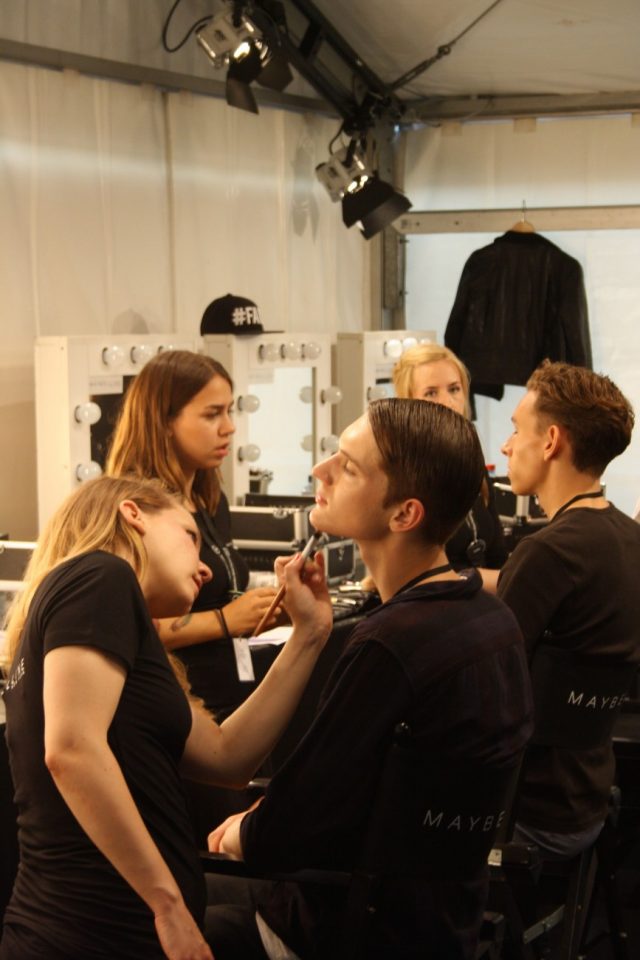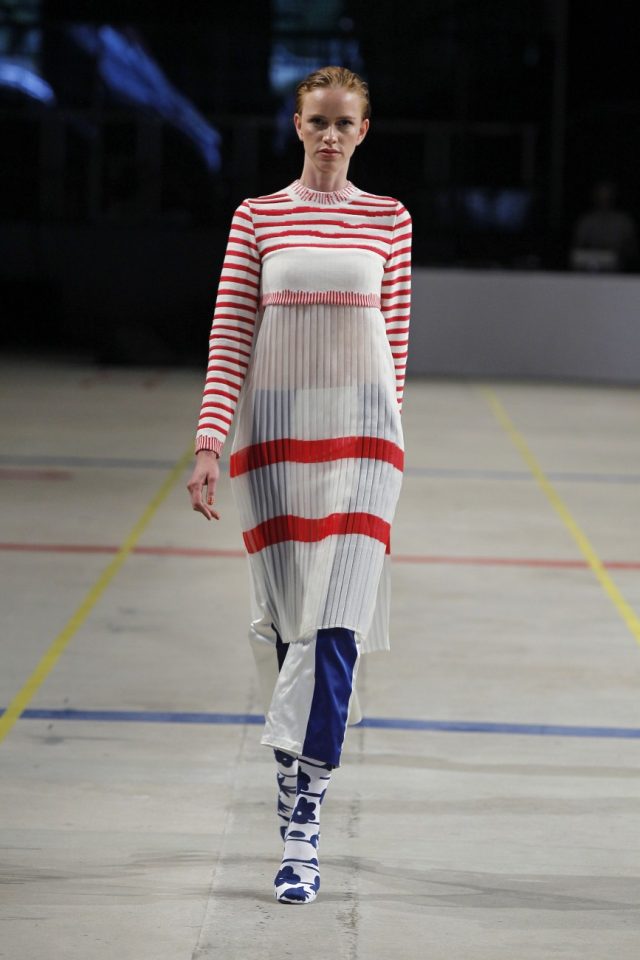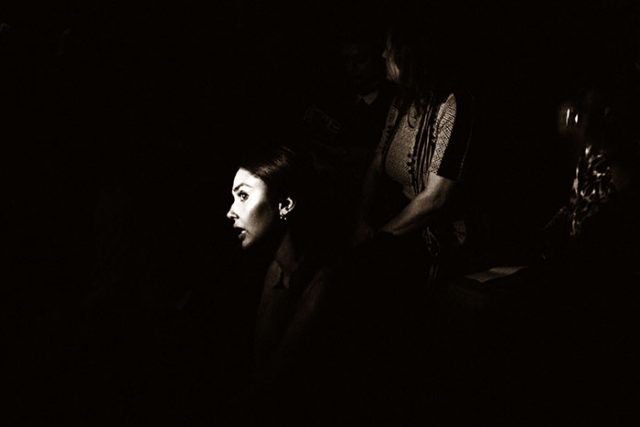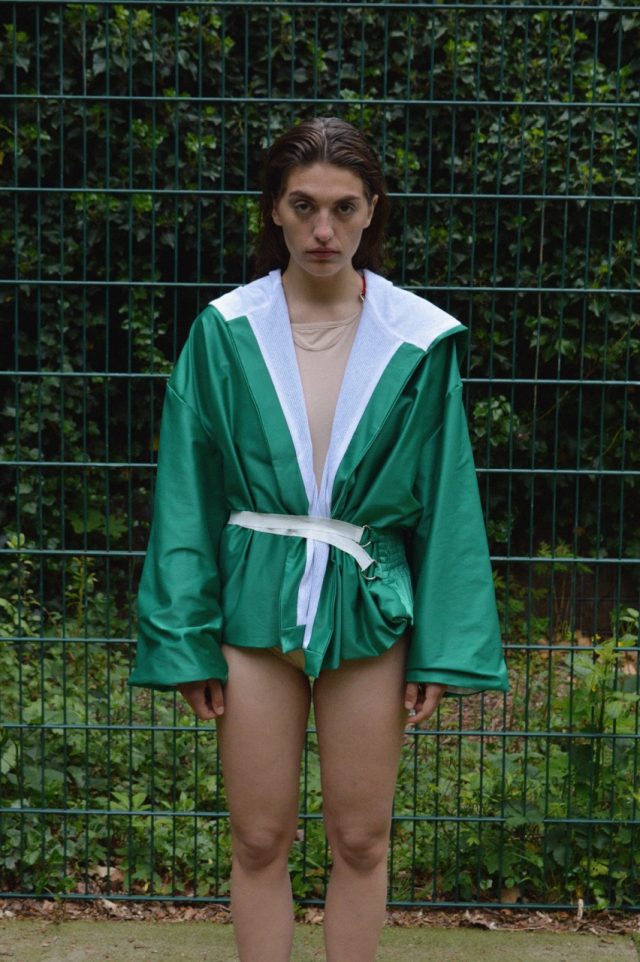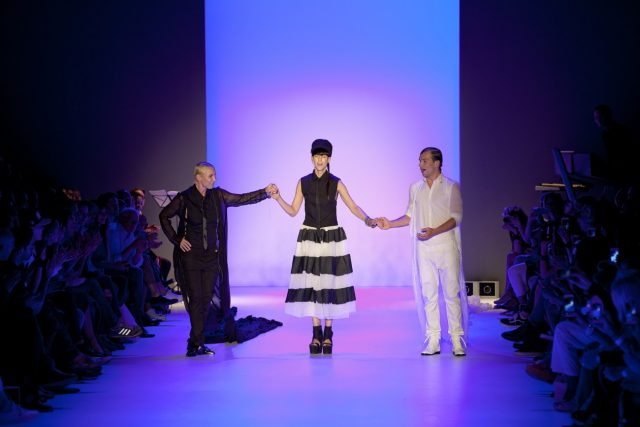 via Axel Engström
via Axel Engström
Though often painted as a world of glamour and frivolous excess, life in the fashion industry often proves herself a cruel mistress. On meeting Odeur Studios‘ Petter Hollström and Gorjan Lauseger, they have arrived fresh from a 4:30am start and an 800-kilometre trek from their native Stockholm. Under similar circumstances, I’d have little faith in my abilities to stand on two feet, yet they appear calm and collected, diving straight into fittings and castings for tomorrow’s presentation of their Autumn/Winter 2016 collection at Brandenburger Tor, the atrium of this season’s Mercedez-Benz Fashion Week.
Amidst the set-up of their space at Gleisdreieck’s Premium trade show, host to their latest collection over the week, the pair were kind enough to take a moment out of their schedule to discuss the brand’s idiosyncratic approach to fashion creation, as well as offering a glimpse of what might lie up tomorrow’s sleeve…
First off, welcome to Berlin! Let’s begin with the admittedly cliché, ‘where and when did you meet?’ How did Odeur start?
Petter Hollström: It all began as a graduation project of mine in 2006. It was never intended as a label, but rather as an experiment in which I used scent to replace the traditional word-based logotype typically used to represent a brand. A Japanese distributor picked it up and it all took off from there… The offer was just too good to say no to! Gorjan and I met two years later, after the fourth or fifth season.
Gorjan Lauseger: I was working at a fashion fair in Stockholm, ‘+46’, at which [Petter] was exhibiting. I then began working at a publication in Sweden and borrowed some of his garments, as well asinterviewing him. We then started meeting for lunch, discussing fashion and what we did and didn’t like.
PH: And after hanging out for some time, we realised that we had the same aesthetic interests, so why not work together?
Your routes into the fashion world were perhaps somewhat unorthodox: Petter, you originally studied Graphic Design, going on to Stockholm’s Berghs School of Communication, and Gorjan, you studied Communication, alongside Marketing. How have your respective educations shaped Odeur?
PH: From the outset, we’ve been very cpnscious of how everything is presented; not just of the fabrics and the quality, fit & style of the garments, but also of how it’s all documented and how we present the garments, be it in a lookbook or whichever other chosen medium. We have consistently been aware that all of these components act as voices of the brand. With respect to our educational backgrounds, they’ve been pivotal in the creation of the label.
I also think that it comes down to the unorthodox ideas we have regarding the uses of materials. This sometimes means that we encounter failures, pretty harsh failures at that.
GL: When we started working together, we didn’t know that much about fabrics, about cuts, about the fit of a garment. It was more a question of what we liked and how we envisaged the end result. Of course, in making mistakes, you learn; that was our ‘school’ in this business.
PH: And it still is! It’s been quite humbling for both of us; we’re both still learning, still becoming acquainted with new materials, as is the case across the fashion industry. Both the collections and we are continuously evolving. Odeur A/W14 ‘Facade’ via Ceen Wahren
Odeur A/W14 ‘Facade’ via Ceen Wahren
If experimenting with fabrics forms such an integral part of your work, do any difficulties arise with having to present within a seasonal framework?
PH: Quite honestly, I don’t think that we feel that way. In certain respects, such as that concerning their effect on the industry’s sustainability, we don’t like the idea of seasons. However, with regard to the creative process, we almost enjoy them; they allow us continual development. If we worked towards the goal of creating a single perfect collection, with nothing to supplant it, I don’t think we would ever be done.
GL: But also we don’t really work in a ‘seasonal’ manner; of course, we use different fabrics in different seasons, but were you to take a garment from S/S16 and another from A/W15, you would find that they compliment one another.
Odeur is renowned above all for its subversion of conventional fashion and paradigms, offering genderless collections marked, not by a “traditional word-based logotype”, but by the infusion of the garments with a distinct scent. What inspired such idiosyncrasy, and how has it shaped your creative process?
PH: It stems from our backgrounds, going back to high school and the trends of that era, characterised by Champion sweatshirts and big brands. The wearing of a brand that you identified with was a mechanism that allowed you to be placed within a group and to find an affinity with others. With my communication studies graduation project, I wanted to convey the idea that design and branding do not always have to work in this way and that fashion can be more personal; a label does not need to create a sense of collective unity. It should be of greater importance to the individual. While you may be aware of the garment’s branded scent, others around you may not. That’s the reasoning behind the creation of a scent, as opposed to a visually prominent logo. But over time, we’ve tried to create design motifs, allowing people to recognise a garment as an Odeur piece.
Due to the digression from gendered norms and focus on form and silhouette above all, your collections have been heralded as avant-garde. To what extent would you agree, and what are the benefits and challenges that such an honourable, yet abstract, labelling bring with it?
GL: When you hear the term ‘avant-garde’, thoughts often turn to something crazy, black and somewhat un-wearable, targeted towards a specific type of person whose style is defined by their exclusive wearing of such clothing. But we are not that kind of brand; our work includes t-shirts and sweatshirts, garments that one can hardly consider ‘crazy’. Through the manipulation of silhouette, you can of course incorporate these elements into something that is perhaps more ‘avant-garde’. But we love to see regular people wearing our garments, to see them take pride in the fact that their purchase is somehow special, as opposed to just being a piece from a large, corporate brand.
PH: Of course, as designers, being afforded the avant-garde label has its perks. It allows us to do some crazy stuff, to be more experimental. Perhaps we’re a bit too Scandinavian, but if you’re looking to our collections for sheer absurdity, you might be disappointed. We aim to create interesting silhouettes, but as Gorjan said, our focus remains on the person in the street, perhaps allowing them to take a step towards something a little more daring. That is the role that we would like to fill. In that respect, the ‘avant-garde’ labelling presents a certain hindrance, since we want to be able to reach everyone. We don’t want to be perceived as an obscure label that only a select few know about, we want to gain more recognition.
GL: It’s funny, especially amongst friends who have little to do with the industry. Often they’ll see a garment and say how much they like it. “Where is it from?”, they ask. On finding out that it’s actually one of our pieces, they’re surprised! And that’s precisely it, they have a preconceived notion of what we’re doing, but it doesn’t necessarily align with how the garments actually look. It’s quite tricky, as people’s thoughts of what Odeur is don’t necessarily align with the reality of what we are doing. Odeur S/S15 ‘Zenith’ via Simon Larsson
Odeur S/S15 ‘Zenith’ via Simon Larsson
How have you consolidated your relatively niche approach to fashion creation with the overbearingly commercialised structures of the fashion industry? Were there any necessary compromises?
PH: That’s not something we’ve ever really given much thought. When we design our collections, we design what we want to see. Gorjan and I are both people that like to wear what we create. Our visions of ourselves and the visions that we identify with are our creative springboards. This is great, allowing us to bring what we feel to the market. Had we chosen a specific path and maximised on the marketing potential there, then perhaps we might have grown much bigger over a much shorter timespan. But we haven’t done that, instead choosing to produce garments that we want to create. Though it may have been a long journey, we’ve done it in a way that we really enjoy.
How do your diffusion lines, Odeur Artefacts and ODR, fit into the Odeur universe?
PH: The Artefacts line was a natural move. We’d long been thinking of producing high quality leather goods that outlasted the seasons. For next season, we will be redesigning some of the pieces for the first time in 8 seasons, a challenge in itself. We’re also working with shoes that both complement and complete the Odeur silhouette, but due to production limitations, we want to focus more on delivering items intended for use across the seasons, as opposed to producing them seasonally. But that’s the natural role that Odeur Artefacts plays, the clue’s in the name.
When it comes to ODR, that line is now defunct. It originally came about after numerous enquiries regarding artist and store collaborations, but it never really took off in the direction we wanted. It was an example of the numerous trials and errors we mentioned earlier. But we then brought in Odeur Basics, consisting of high quality basic garments that we try to offer at reasonable prices. Odeur A/W15 ‘Opposite/Me’ via Simon Larsson
Odeur A/W15 ‘Opposite/Me’ via Simon Larsson
In terms of place, you seem to have somewhat avoided the traditional routes. You are currently based in Stockholm and you are showing in Berlin this season, having previously done so. As well as your home base, you’ve also shown in Copenhagen and Shanghai. While all of these are fashion capitals in their own right, they perhaps lack the immediate structures and networks of “the Big Four”. Has the situating of yourself outside of these geographical contexts at all influenced your work?
PH: It’s difficult to say since we’ve never worked in these cities. We’re familiar with Paris, New York, London and Milan to a good degree, and we are aware of what’s being showcased there. Many people tell us that we should go there and show, but for us, it comes down to what works organically for us. Here in Berlin, we have a fan-base, as well as great collaborative partners, thereby enabling us to do what we want to do.
In an interview with Deux Hommes, you stated that with your S/S15 collection, you “had the buyer in focus, the person whose life stands in ‘zenith’”. Is this a philosophy that carries over into the general corpus of Odeur? Is there an archetypal Odeur customer, or do you design with one in mind?
PH: Yes, I think so. It’s important to consider how the buyer of the garment want’s to be perceived. Of course that is a focus. But in designing, we’re not focusing on a specific target group; we’re designing for ourselves. We do what we want and we offer it to our clients; if they like it, they like it. If they don’t, they don’t.
With the “Zenith” collection, we were personally very much in that state, the moment where everything is possible, before falling into a perhaps more established context. There’s a lot of emotion invested in our collections.
Does Odeur continue to exist in a state of zenith?
PH: It’s difficult to say. That feeling was extremely present when we designed that collection. As individuals, I think both Gorjan and I constantly feel that we are. But we constantly receive signs that things are changing. That collection was also perhaps rather egotistical, in the sense that it dealt with the individual and what they mean to the outside world, versus this coming collection, which deals far more with the feelings of the individual towards the outside world, the giving of perspective to others and the placing of things in new contexts.
Could you perhaps give us a little hint of what to expect of tomorrow’s presentation?
PH: You’ll be seeing the trademarks of the Odeur aesthetic. We will be building on what we have been establishing for the last two collections at least, with slightly oversized, long silhouettes. You might even see some shades of colour! I won’t say how much, but I’m sure it will prove to be interesting. All in all, I would prepare to see an updated version of the Odeur silhouette.
